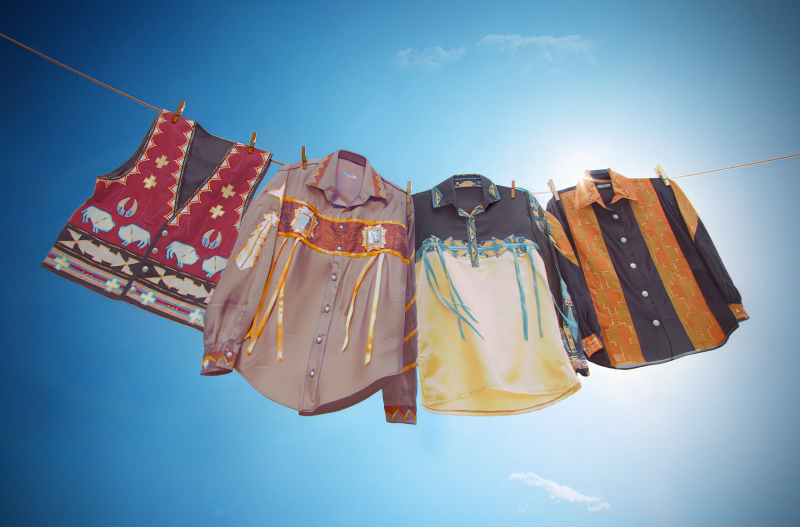
“Is that a Penny Singer?”
Every August, the annual Santa Fe Indian Market in New Mexico draws hundreds of Indigenous artists who come to sell and display their new contemporary works. Among the bustling crowd and booths, you’re bound to see a handful of patrons boasting about their brand-new Penny Singer ribbon shirts; the Navajo designer is one of the market’s most popular attractions. “I love when people come to my booth and are amazed at what I do,” Singer tells Vogue. “That’s what keeps me going; I love meeting new people, and talking to them about what I put on my garments.”
Singer—who is based on the Navajo reservation in New Mexico—has been a mainstay at the national Indigenous market for over a decade (she also shows at other tentpole markets, such as the Heard Market in Phoenix, Arizona). “[Santa Fe] Indian Market is my biggest,” says Singer. “That's pretty much my income.” Particularly, the designer has become known over the years for her striking ribbon shirts, crafted for both men and women (she also designs jackets and skirts). “I’m known for contemporary geometric appliqué work,” says Singer. “I create contemporary wearable art that both Natives and non-Natives can wear.”
The designer’s successful fashion line first began back in the 2000s, when Singer was beginning to study traditional design techniques in college. She specifically took an interest in southwest appliqué styles. “I knew how to sew, but appliqué was new to me,” says Singer. “I had no idea what that was; I ended up making my first ribbon shirt.” Popularly worn by powwow dancers from many different nations, ribbon shirts are typically worn by men to display their Indigenous pride and feature colors and patterns specific to their tribes or communities. Singer became interested in putting her own stamp on the time-honored design. “At the time, my son’s dad was a southern straight dancer; he danced powwows,” says Singer. “I taught myself how to make him ribbon shirts. [My line] evolved from that.”
Eventually, Singer started producing and selling her own ribbons shirts at various markets such as Santa Fe—something she’s been doing for the past 15 years now. Today, they’re her most popular item—so much so that she often sells out within a day or two. “All my best pieces usually happen a month before showtime,” says Singer of her creative process. “I don’t really do sketches; It’s just how I feel when I start to make it.” When it comes to her distinctive geometric appliqués, everything is done by hand. “I draw the design onto Wonder-Under adhesive, and then iron it onto fabric and cut the designs out,” says Singer. “Then, when I have my garments cut, I iron the appliqués onto the garment, and free-hand a zigzag stitch.”
Singer’s striking pieces were recently put on display at the inaugural SWAIA Native Fashion Week earlier this month, also held in Santa Fe. The runway show featured brand new ribbon shirts, vests, skirts, and jackets, all showcasing her signature craftwork style. “I opened with urban-cool looks—streetwear pieces you can wear with jeans—and I ended with more formal looks,” says Singer. Many of the pieces took inspiration from daily life on the Navajo reservation. “That’s where all of our old weaving designs came from—the landscapes, and just living out on the rez.”
Singer's more causal pieces included a yellow sateen ribbon shirt with teal detailing. “It’s a contemporary appliqué ribbon shirt, with geometric designs that I drew on graph paper,” she says. “The print kind of looks like beadwork; I draw a lot with rulers and liners.” The designer also created a gold ribbon shirt with photographs of tipis that Singer took herself. “I took those photos maybe 15 or 20 years ago, back in California [when] I used to travel to a lot of powwows. I love photography. I tell stories through my photography.”
Singer’s formal offering, meanwhile, is a black geometric-print cape for evening. “It’s inspired by my grandmother—I pay a lot of tributes to her through my garments,” says Singer of the look. “I grew up watching and learning from her. She weaved, and the top of the [cape] shoulders is a design that my grandmother had on one of her rugs.” Featuring a turquoise trim, the garment also nods back to Singer’s cultural roots. “I always put a pop of turquoise on my designs,” she says. “You'll see either turquoise embroidery or stitching. For us Navajos, and probably other nations, it's a form of beauty and protection.”
Given the success of her first SWAIA Native Fashion Week this month, Singer hopes to showcase at even more Indigenous fashion weeks in the future. “It's been a goal of mine to challenge myself and do more fashion shows,” says Singer. (With a growing fanbase, perhaps she'll be showing at Santa Fe Indian Market’s annual Indigenous Fashion Show come August.) And as for her August collection, we can expect more bold, statement-making pieces. “When [customers] purchase something, I always tell them, ‘Be careful—you're going to get a lot of looks,’” laughs Singer. “And they always come back the next year and say, ‘You were right!’”

